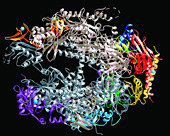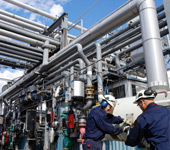Industry

Power transmission
Cables made of superconducting material can carry far more electricity than conventional cables with minimal power losses. Underground copper transmission lines or power cables are near their capacity in many densely populated areas, and superconducting cables offer an opportunity to meet continued need. Further superconducting technology advances in particle physics will help contribute to this nascent industry.

Transportation
Magnetically levitating trains use powerful superconducting magnets to suspend and propel the train. Mag-lev trains are fast and quiet compared to wheeled mass-transit systems, potentially reaching velocities comparable to jet aircraft. The superconducting magnet technology developed for particle physics will play a key role in the future of this mode of travel.

Biomedicine and drug development
Biomedical scientists use particle physics technologies to decipher the structure of proteins, information that is key to understanding biological processes and healing disease. To determine a protein's structure, researchers direct the beam of light from an accelerator called a synchrotron through a protein crystal. The crystal scatters the beam onto a detector. From the scattering pattern, computers calculate the position of every atom in the protein molecule and create a 3-D image of the molecule. A clearer understanding of protein structure allows for the development of more effective drugs. Abbott Labs' research at Argonne National Laboratory's Advanced Photon Source was critical in developing Kaletra®, one of the world's most prescribed drugs to fight AIDS. Next-generation light sources will offer still more precise studies of protein structure without the need for crystallization.

Understanding turbulence
Turbulence is a challenge to all areas of fluid mechanics and engineering. Although it remains poorly understood and poorly modeled, it is a dominant factor determining the performance of virtually all fluid systems, including long-distance oil pipelines, fuel injection systems and models for global weather prediction. Improvements to our knowledge will have payoffs in reducing energy losses in fuel transport, improving efficiency of engines and deepening our understanding of global climate behavior. Technology developed for particle physics and applied to problems of turbulence has extended our understanding of this difficult phenomenon by more than tenfold. Silicon strip detectors and low-noise amplifiers developed for particle physics are used to detect light scattered from microscopic tracer particles in a turbulent fluid. This technique has permitted detailed studies of turbulence on microscopic scales and at Reynolds numbers more than an order of magnitude beyond any previous experimental reach.
- Last modified
- 05/01/2014
- email Fermilab








